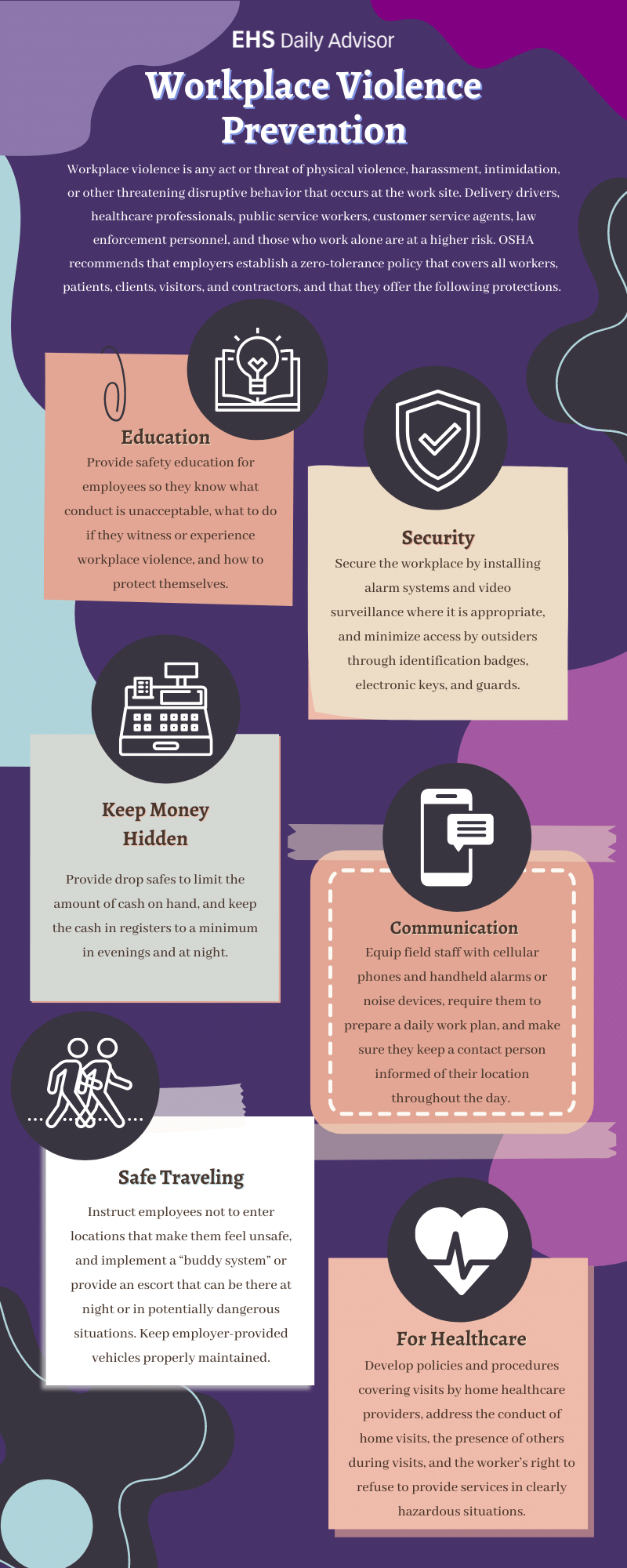Recognizing Lawful Needs for California Workplace Violence Prevention Programs
Recognizing Lawful Needs for California Workplace Violence Prevention Programs
Blog Article
The Duty of Staff Member Training and Understanding in Enhancing Office Violence Avoidance Initiatives Across Different Industries
The integration of worker training and awareness right into workplace physical violence prevention efforts is significantly recognized as a basic facet of organizational security throughout diverse markets. By implementing targeted training programs, services can efficiently equip their labor force to identify and attend to possible threats before they intensify. Nonetheless, the performance of these initiatives commonly pivots on several vital variables that vary by industry, raising crucial inquiries concerning the adaptability of training methods and their real-world effect. Comprehending these nuances may disclose strategies that can significantly enhance safety methods and staff member self-confidence in risky atmospheres.
Importance of Educating Programs
In today's dynamic workplace, the significance of training programs can not be overstated, specifically in the context of work environment violence avoidance. These programs work as a foundational component in cultivating a risk-free and safe and secure workplace society. By equipping workers with the understanding and abilities essential to recognize, minimize, and respond to prospective risks, companies can promote an environment that focuses on safety and health.
Effective training programs do greater than merely instruct; they equip employees to acknowledge warning indications of violence, comprehend the methods for reporting incidents, and create techniques to de-escalate possible conflicts. They infuse a sense of collective duty amongst personnel, encouraging proactive engagement in maintaining a safe work environment.
Financial investment in training not just enhances worker awareness however additionally shows an organization's commitment to protecting its labor force. This aggressive approach can bring about lowered incidents of work environment physical violence, lower absenteeism, and improved worker spirits. Ultimately, thorough training programs are integral to establishing a durable organizational culture that values security and advertises a healthy and balanced work setting, therefore reducing the risk of violence and its associated repercussions.
Trick Components of Effective Awareness
A comprehensive awareness program incorporates numerous crucial elements that are vital for efficiently stopping workplace physical violence. First, clear communication of policies and treatments associated with office physical violence is important. Workers should be educated regarding the organization's position on violence and the details procedures in position for reporting cases.
Second, training sessions need to integrate realistic circumstances that workers might come across. This practical strategy assists staff members acknowledge advising indications of potential physical violence and equips them with the essential skills to de-escalate strained situations. Third, promoting a supportive office culture is essential; workers need to feel encouraged to speak up without anxiety of revenge.
Additionally, recurring education is necessary to keep recognition pertinent and fresh. Routine correspondence course and updates on arising threats can improve workers' alertness and preparedness. Finally, incorporating comments systems permits employees to share their insights and experiences, which can bring about continuous improvement of understanding efforts. By integrating these components, organizations can develop a durable structure for preventing workplace physical violence, inevitably adding to a safer and more productive environment for all workers.
Industry-Specific Training Approaches
Reliable office physical violence prevention training have to be customized to the special difficulties and risks faced by specific sectors. Healthcare settings call for training that resolves the high probability of encounters with aggressive people or visitors. Programs ought to concentrate on de-escalation strategies, recognizing caution indications of potential physical violence, and making sure staff understand the significance of Get More Information reporting incidents.
In contrast, retail settings might deal with various risks, such as break-in or customer disagreements. Training in these environments must stress situational awareness, action procedures during emergency situations, and the importance of safeguarding money and valuables.
Manufacturing and building sectors present their own threats, commonly linked with social disputes or harmful working conditions. Training in these markets need to include methods for dispute resolution, advertising a society of safety, and motivating open interaction amongst employees.
Moreover, company offices may need training focused on protecting against harassment and bullying, fostering a respectful work environment culture, and applying clear coverage devices. Each industry should not only acknowledge its certain susceptabilities but likewise adjust training products to reverberate with the labor force successfully, making certain that staff members really feel complete and encouraged to handle potential my response violent situations.
Determining Training Effectiveness
Assessing the effect of workplace violence avoidance training is critical for ensuring that employees are effectively prepared to manage prospective dangers. To precisely determine training effectiveness, organizations should apply both qualitative and measurable evaluation methods. Pre- and post-training studies can determine adjustments in worker understanding, mindsets, and actions concerning work environment violence. These surveys need to focus on specific training goals to ensure positioning with the company's goals.
Furthermore, useful analyses, such as role-playing situations or simulations, can provide understandings into just how well workers use found out skills in real-life situations. Keeping an eye on incident records prior to and after training can also work as an indication of performance, as a decrease in occurrences might reflect improved worker readiness.
Moreover, responses from participants need to be systematically gathered to recognize areas for enhancement in training web content and delivery. Performing follow-up examinations at normal intervals assists endure awareness and reinforces training principles with time - california workplace violence prevention. By using a thorough method to determining training performance, companies can make certain that their office violence prevention initiatives promote a safer atmosphere and boost total employee well-being
Building a Culture of Security

Training plays a pivotal role in this cultural shift. Regular, extensive training sessions enlighten workers regarding acknowledging caution indicators of office physical violence and the suitable reactions. Moreover, motivating open communication enables workers to voice issues without concern of vengeance, advertising collective responsibility for safety.
Additionally, integrating safety and security right into everyday operations ensures that it comes to be a shared value instead of a plain conformity issue. This includes normal security drills, updates on policies, and responses systems that include employees in safety and security conversations and improvements.
Ultimately, a durable culture of safety not just mitigates the threats of office violence but additionally improves employee spirits and efficiency. By fostering an atmosphere where safety is a basic top priority, organizations can create durable workplaces that sustain both individual health and collective success.
Conclusion
In final thought, staff member training and awareness are important elements in the avoidance of office physical violence throughout various industries. Effective training programs, customized to specific industry requirements, improve workers' capacity to react and identify to possible hazards.

Regular, thorough training sessions enlighten staff members regarding acknowledging warning signs of work environment physical violence and the proper reactions.In conclusion, employee training and awareness are essential parts in the avoidance of work environment violence throughout different markets.
Report this page